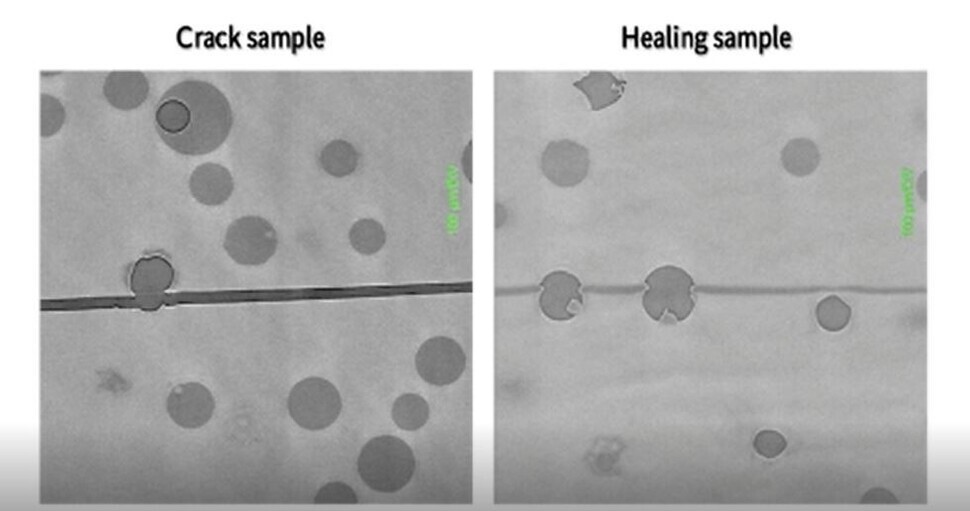hankyoreh
Links to other country sites 다른 나라 사이트 링크
KIST develops transparent material for smartphone screens capable of repairing itself

In the “Terminator 2: Judgement Day,” the T-1000 can’t be stopped by bullets. The shapeshifting android has self-healing properties that repair damage in the blink of an eye.
But this technology — once feasible solely in the realm of the cinema — is now becoming a reality. In the near future, it’s likely that smartphone users won’t have to fork over money to repair a cracked screen. Researchers have developed a material for smartphone liquid crystal displays that can repair itself in 12 hours at room temperature and in just 20 minutes under UV rays.
The Korea Institute of Science and Technology (KIST) announced on Nov. 19 that it had developed a self-healing transparent electronic material capable of repairing cracks and other damage. The study was carried out by two research teams, one led by Jung Yong-chae, director of KIST’s Composite Materials Applications Research Center, and the other by Han Hak-su, a professor at Yonsei University.

The material these researchers have developed is a self-healing transparent polyimide that represents an upgrade to colorless and transparent polyimide, used in foldable phones. The new material is augmented with the ability to quickly and easily repair cracks or any other damage.
Flaxseed oil (extracted from the seeds of the flax plant) is placed in tiny capsules that are embedded in a protective silicon coating above the transparent polyimide. Damage to the material breaks the capsules, releasing the flaxseed oil, which then flows into the damaged areas and repairs them. If this product is commercialized, smartphone screens would no longer need to be covered with protective film.

Prior to this, it had only been possible to achieve self-healing properties in soft materials, and those properties could only be activated by applying heat. But the newly developed material has the advantage of being hard and of repairing itself at room temperature (though humidity and UV rays accelerate the repair process). The material can repair 95% of damage within 12 hours at room temperature and within 10-20 minutes under UV rays.
“Self-healing transparent polyimide can provide a fundamental solution to lifespan issues and the physical properties of damaged polymers. This represents a significant expansion of the applicability of materials such as flexible displays and electronic materials,” said Jung Yong-chae.
By Song Chae Kyung-hwa
Please direct comments or questions to [english@hani.co.kr]

Editorial・opinion
![[Column] Has Korea, too, crossed the Rubicon on China? [Column] Has Korea, too, crossed the Rubicon on China?](https://flexible.img.hani.co.kr/flexible/normal/500/300/imgdb/original/2024/0419/9317135153409185.jpg) [Column] Has Korea, too, crossed the Rubicon on China?
[Column] Has Korea, too, crossed the Rubicon on China?![[Correspondent’s column] In Japan’s alliance with US, echoes of its past alliances with UK [Correspondent’s column] In Japan’s alliance with US, echoes of its past alliances with UK](https://flexible.img.hani.co.kr/flexible/normal/500/300/imgdb/original/2024/0419/2317135166563519.jpg) [Correspondent’s column] In Japan’s alliance with US, echoes of its past alliances with UK
[Correspondent’s column] In Japan’s alliance with US, echoes of its past alliances with UK- [Editorial] Does Yoon think the Korean public is wrong?
- [Editorial] As it bolsters its alliance with US, Japan must be accountable for past
- [Guest essay] Amending the Constitution is Yoon’s key to leaving office in public’s good graces
- [Editorial] 10 years on, lessons of Sewol tragedy must never be forgotten
- [Column] A death blow to Korea’s prosecutor politics
- [Correspondent’s column] The US and the end of Japanese pacifism
- [Guest essay] How Korea turned its trainee doctors into monsters
- [Guest essay] As someone who helped forge Seoul-Moscow ties, their status today troubles me
Most viewed articles
- 1[Column] The clock is ticking for Korea’s first lady
- 2[Correspondent’s column] In Japan’s alliance with US, echoes of its past alliances with UK
- 3Samsung barricades office as unionized workers strike for better conditions
- 4After 2 months of delayed, denied medical care, Koreans worry worst may be yet to come
- 5[Column] Has Korea, too, crossed the Rubicon on China?
- 6[Editorial] When the choice is kids or career, Korea will never overcome birth rate woes
- 7Hong Se-hwa, voice for tolerance whose memoir of exile touched a chord, dies at 76
- 8US overtakes China as Korea’s top export market, prompting trade sanction jitters
- 9Constitutional Court rules to disband left-wing Unified Progressive Party
- 10Nearly 1 in 5 N. Korean defectors say they regret coming to S. Korea